Mold Release Coatings Market Size 2025-2029
The mold release coatings market size is valued to increase USD 324 million, at a CAGR of 5.9% from 2024 to 2029. High usage in the food processing industry will drive the mold release coatings market.
Major Market Trends & Insights
- APAC dominated the market and accounted for a 48% growth during the forecast period.
- By Type - Water-based segment was valued at USD 518.20 million in 2023
Market Size & Forecast
- Market Opportunities: USD 51.74 million
- Market Future Opportunities: USD 324.00 million
- CAGR from 2024 to 2029 : 5.9%
Market Summary
- Mold release coatings, a vital component in various industries, have experienced significant growth due to their essential role in manufacturing processes. These coatings facilitate the release of finished products from molds without damage or residue, reducing production downtime and costs. According to a market study, the market was valued at over USD 2.5 billion in 2020. Key drivers for this market include the increasing demand in industries such as food processing and building and construction. In food processing, mold release coatings ensure the production of high-quality, consistent products, while in construction, they contribute to the efficient manufacturing of architectural glass, concrete products, and other building materials.
- However, the market faces challenges in the automotive industry's slowdown due to the shift towards electric vehicles and lightweight materials, which may decrease the demand for traditional mold release coatings. Despite these challenges, the market's future remains promising. Innovations in technology, such as the development of eco-friendly and high-performance coatings, are expected to drive growth. Additionally, the increasing focus on automation and lean manufacturing processes will further boost the market's expansion. Overall, mold release coatings continue to play a pivotal role in various industries, ensuring efficient manufacturing processes and high-quality end products.
What will be the Size of the Mold Release Coatings Market during the forecast period?
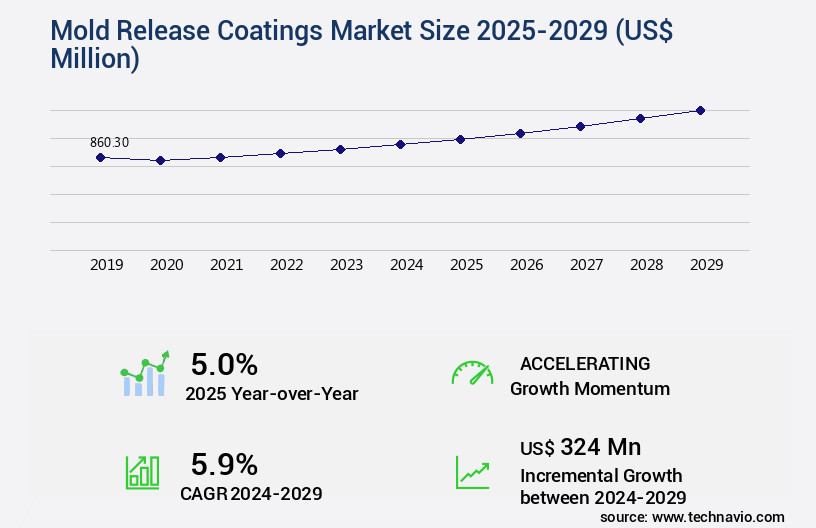
Get Key Insights on Market Forecast (PDF) Request Free Sample
How is the Mold Release Coatings Market Segmented ?
The mold release coatings industry research report provides comprehensive data (region-wise segment analysis), with forecasts and estimates in "USD million" for the period 2025-2029, as well as historical data from 2019-2023 for the following segments.
- Type
- Water-based
- Solvent-based
- Geography
- North America
- APAC
- China
- India
- Japan
- South Korea
- Rest of World (ROW)
By Type Insights
The water-based segment is estimated to witness significant growth during the forecast period.
Water-based mold release coatings have gained significant traction in various industries due to their eco-friendly composition and versatile applications. These coatings, primarily composed of water, are increasingly preferred over solvent-based alternatives. For instance, in the building and construction sector, water-based coatings are favored for use with concrete molds, as concrete works optimally with water. This shift from solvent-based to water-based mold release coatings is driven by environmental and health concerns. Solvent-based coatings, including epoxy release agents and urethane release coatings, can contain allergens and produce unpleasant odors. Moreover, they have higher volatile organic compound (VOC) emissions and require stringent contamination control measures.
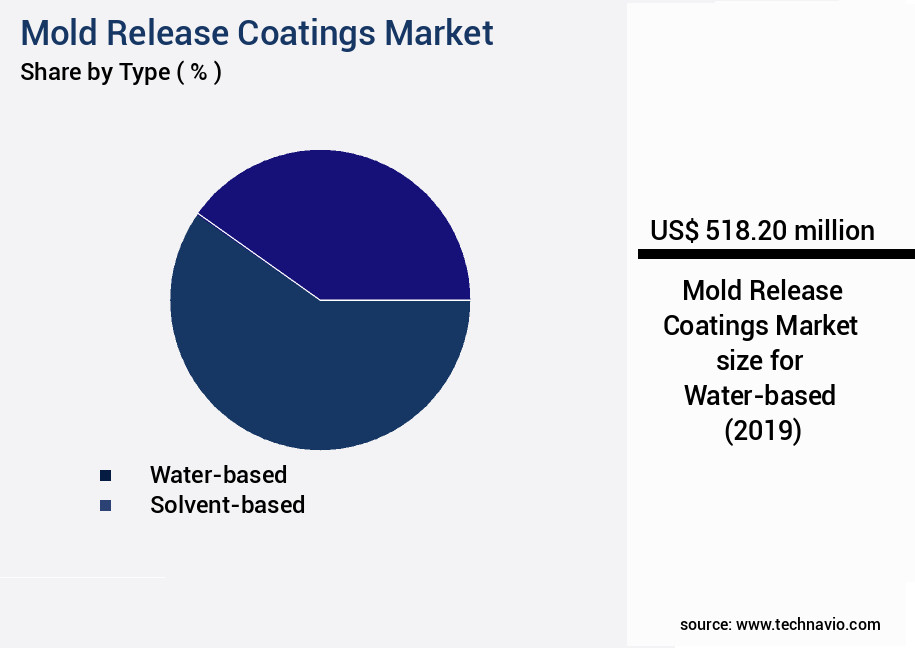
Request Free Sample
The Water-based segment was valued at USD 518.20 million in 2019 and showed a gradual increase during the forecast period.
Water-based coatings, such as acrylic and fluoropolymer ones, offer desirable properties like release film thickness, surface energy reduction, and coating rheology. They ensure part ejection force, improve cycle life, and reduce defects. Additionally, water-based coatings exhibit excellent abrasion resistance, chemical resistance, and coating adhesion strength. Their viscosity can be controlled for efficient application methods, and they can be cured at both low and high temperatures.
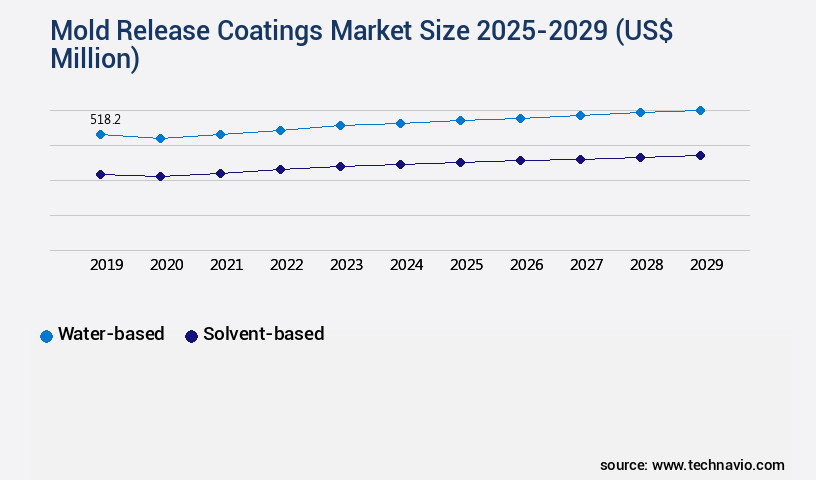
Request Free Sample
Regional Analysis
APAC is estimated to contribute 48% to the growth of the global market during the forecast period. Technavio's analysts have elaborately explained the regional trends and drivers that shape the market during the forecast period.
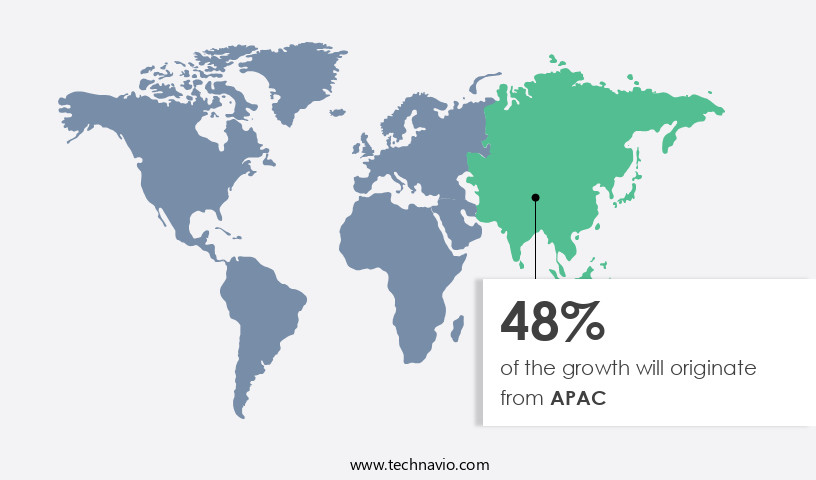
See How Mold Release Coatings Market Demand is Rising in APAC Request Free Sample
The market is experiencing significant growth, particularly in the Asia Pacific (APAC) region. This expansion is driven by increasing demand from industries such as building and construction and automotive. In APAC, countries like India, Vietnam, Thailand, and Malaysia are emerging as major players due to their low labor costs and lack of stringent regulations, fueling the growth of the construction industry. The automobile sector is another significant consumer of mold release coatings. These coatings are utilized in the manufacturing of various automobile components, including passenger and light truck parts, commercial vehicles, winter tires, and intricate automobile parts like instrument panels, door panels, airbag covers, steering wheels, assist handles, armrests, headrests, and seat covers.
The in-mold process is commonly used to manufacture these components, ensuring a smooth and defect-free surface. The market is expected to continue its robust expansion in the coming years.
Market Dynamics
Our researchers analyzed the data with 2024 as the base year, along with the key drivers, trends, and challenges. A holistic analysis of drivers will help companies refine their marketing strategies to gain a competitive advantage.
The market is a critical segment in the manufacturing industry, particularly in the production of complex components and parts. These coatings play a vital role in optimizing silicone release agent application and improving mold release coating durability, ensuring seamless part ejection and minimizing defects, especially in fluoropolymer release coatings. Surface preparation significantly impacts release coatings' effectiveness. Thorough cleaning and proper surface treatment are essential to ensure the adhesion strength of release coatings and their ability to withstand the rigors of the manufacturing process. Measuring release coating thickness and choosing appropriate release agents for complex molds are crucial aspects of the application process. Improving the chemical resistance of release coatings is also essential to extend their lifespan and reduce the need for frequent replacements. Assessing the environmental impact of release agents and analyzing application techniques are critical considerations for manufacturers. Minimizing volatile organic compound (VOC) emissions from release coatings and controlling coating viscosity for uniform application are essential for maintaining a sustainable manufacturing process. Evaluating the effectiveness of different release agents and testing their abrasion resistance is necessary to ensure the best possible performance. Understanding the effects of part geometry on release coatings and improving the cycle life of molds using release coatings are also essential for maximizing productivity and reducing production costs. Managing contamination control during coating application and enhancing the surface finish of molded parts are additional benefits of using release coatings. By optimizing curing conditions and reducing part ejection force, manufacturers can improve overall manufacturing efficiency and ensure high-quality end products.
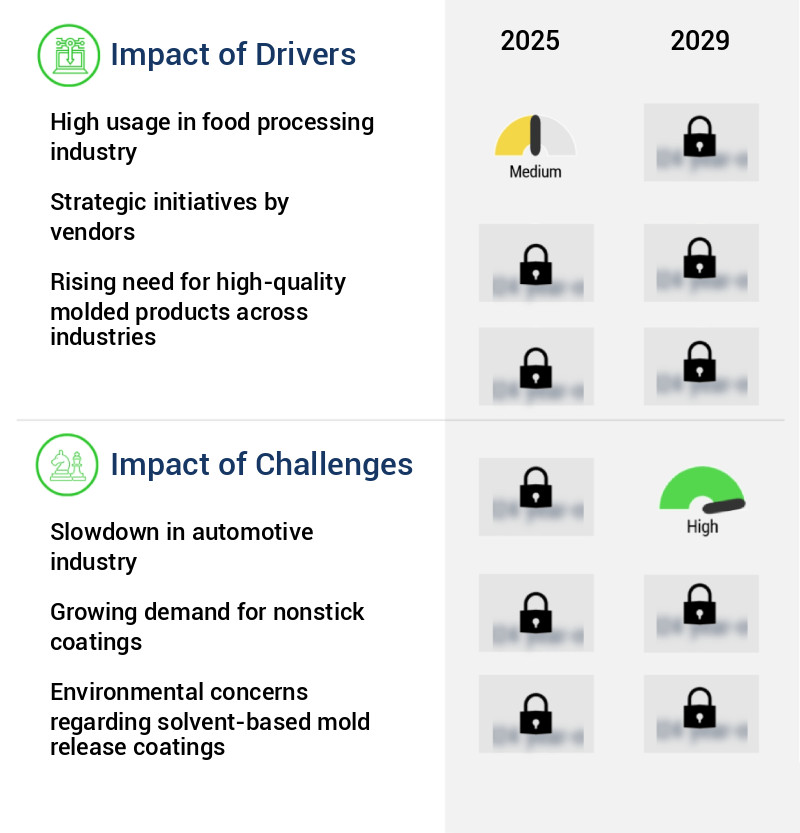
What are the key market drivers leading to the rise in the adoption of Mold Release Coatings Industry?
- In the food processing industry, the significant usage of various processing techniques and technologies is the primary growth driver.
- The market plays a pivotal role in the food processing industry, addressing the challenges of efficient and safe food processing. These coatings prevent food materials from sticking to containers during various stages, such as heating, baking, and frying. The market's significance extends beyond large-scale food processing facilities to small-scale food service providers, including restaurants, caterers, and bakers. The coatings ensure the easy release of food materials, maintaining their desired texture and preventing waste.
- The market's applications span across diverse materials, including metals, plastics, and glass. By facilitating seamless food processing, mold release coatings contribute to the industry's overall productivity and hygiene standards.
What are the market trends shaping the Mold Release Coatings Industry?
- The building and construction industry is experiencing significant growth and is currently a prominent market trend.
- Mold release coatings play a crucial role in the building and construction sector, particularly in the production of concrete products such as blocks, pillars, and slabs. These coatings are applied to molds to minimize adhesion between the concrete and the mold, thereby reducing damage to the concrete and decreasing wastage. The construction of roads, highways, bridges, and buildings relies heavily on the use of mold release coatings, leading to increased efficiency and cost savings. The surge in infrastructure development, driven by government funding and support, has fueled the demand for mold release coatings in recent years. This trend is expected to continue as construction activities expand globally.
- Mold release coatings are an essential component in the manufacturing process, ensuring the production of high-quality concrete products while reducing waste and production costs.
What challenges does the Mold Release Coatings Industry face during its growth?
- The automotive industry's growth is being significantly impacted by a deceleration in its production and sales sectors.
- The market is undergoing transformative changes, with its scope extending beyond the traditional automotive sector. Although the automotive industry's slowdown, influenced by economic fluctuations and geopolitical tensions, has resulted in reduced demand for mold release coatings, the market's evolution is far from stagnant. In fact, the healthcare, construction, and electronics industries are witnessing a surge in the adoption of these coatings due to their inherent benefits, such as improved product quality and reduced manufacturing costs. For instance, the healthcare sector's demand for medical devices and pharmaceutical packaging is driving the market's growth, while the construction industry's focus on energy efficiency and durability is leading to increased demand for mold release coatings in insulation materials.
- The market's resilience is further underscored by its ability to adapt to evolving industry trends and consumer needs.
Exclusive Technavio Analysis on Customer Landscape
The mold release coatings market forecasting report includes the adoption lifecycle of the market, covering from the innovator's stage to the laggard's stage. It focuses on adoption rates in different regions based on penetration. Furthermore, the mold release coatings market report also includes key purchase criteria and drivers of price sensitivity to help companies evaluate and develop their market growth analysis strategies.
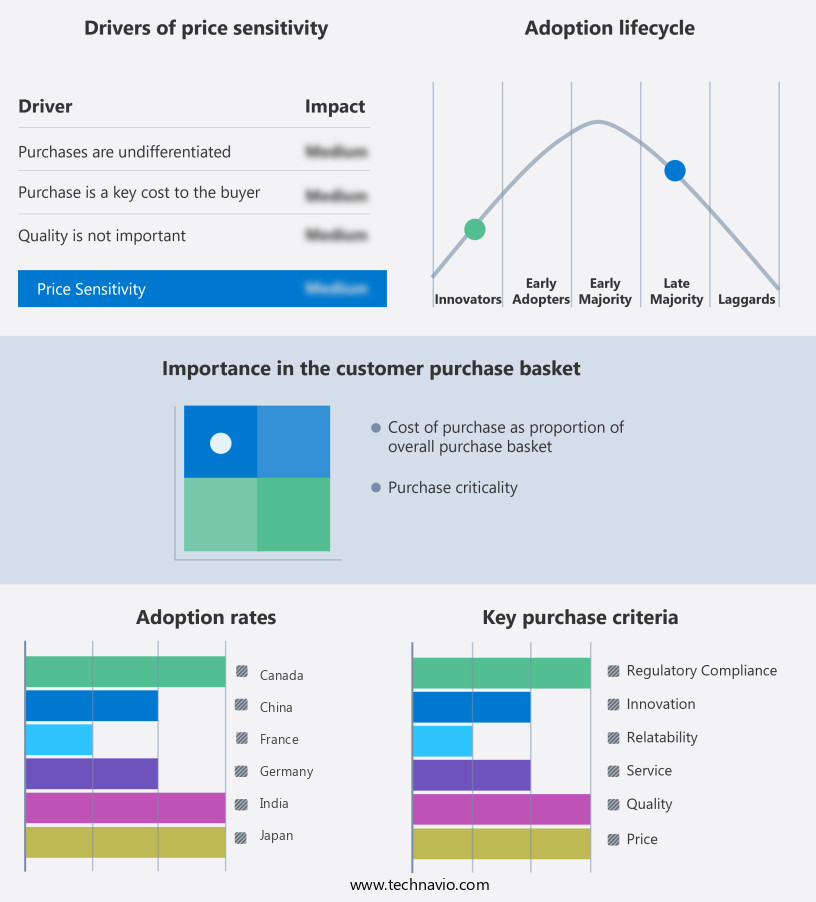
Customer Landscape of Mold Release Coatings Industry
Competitive Landscape
Companies are implementing various strategies, such as strategic alliances, mold release coatings market forecast, partnerships, mergers and acquisitions, geographical expansion, and product/service launches, to enhance their presence in the industry.
Chem Trend LP - Mold release coatings, such as Chem-Trend Lusin Mold Release Products, are essential in manufacturing processes for thermoplastic materials.
The industry research and growth report includes detailed analyses of the competitive landscape of the market and information about key companies, including:
- Chem Trend LP
- CHUKYO Europe GmbH
- Chukyo Yushi Co. Ltd.
- Cresset Chemical Co.
- Cross Technologies Group Inc.
- DAIKIN Chemical Europe GmbH
- Dow Inc.
- Elkem ASA
- Grignard Co. LLC
- Henkel AG and Co. KGaA
- Lanxess AG
- Marbocote Ltd.
- McGee Industries Inc.
- Michelman Inc.
- Miller Stephenson Inc.
- Nanoplas Inc.
- Parker Hannifin Corp.
- TAG Chemicals GmbH
Qualitative and quantitative analysis of companies has been conducted to help clients understand the wider business environment as well as the strengths and weaknesses of key industry players. Data is qualitatively analyzed to categorize companies as pure play, category-focused, industry-focused, and diversified; it is quantitatively analyzed to categorize companies as dominant, leading, strong, tentative, and weak.
Recent Development and News in Mold Release Coatings Market
- In January 2024, BASF SE, a leading chemical producer, announced the launch of its new mold release coating, UltraCote RS 520, designed for use in the automotive industry. This innovative product offers improved release properties and reduced emissions, making it a significant advancement in the market (BASF press release, 2024).
- In March 2024, DuPont and 3M, two major players in the mold release coatings industry, entered into a strategic collaboration to develop and commercialize advanced, high-performance mold release agents. This partnership combines DuPont's expertise in silicones and 3M's knowledge in particle science, aiming to deliver superior solutions to customers (DuPont press release, 2024).
- In May 2024, Wacker Chemicals AG completed the acquisition of the mold release coatings business of Momentive Performance Materials Inc. This acquisition strengthened Wacker's position in the global market and expanded its product portfolio, adding key technologies and customers (Wacker Chemicals AG press release, 2024).
- In January 2025, the European Chemicals Agency (ECHA) approved the renewal of Dow Inc.'s authorization for Hylomar 184, a popular mold release agent used in various industries. This approval ensures the continued availability of this product in the European market, maintaining its significant market share (Dow Inc. Press release, 2025).
Dive into Technavio's robust research methodology, blending expert interviews, extensive data synthesis, and validated models for unparalleled Mold Release Coatings Market insights. See full methodology.
|
Market Scope
|
|
Report Coverage
|
Details
|
|
Page number
|
163
|
|
Base year
|
2024
|
|
Historic period
|
2019-2023 |
|
Forecast period
|
2025-2029
|
|
Growth momentum & CAGR
|
Accelerate at a CAGR of 5.9%
|
|
Market growth 2025-2029
|
USD 324 million
|
|
Market structure
|
Fragmented
|
|
YoY growth 2024-2025(%)
|
5.0
|
|
Key countries
|
US, China, South Korea, India, and Japan
|
|
Competitive landscape
|
Leading Companies, Market Positioning of Companies, Competitive Strategies, and Industry Risks
|
Request Free Sample
Research Analyst Overview
- The market continues to evolve, driven by the diverse requirements of various sectors. Epoxy and silicone release agents remain popular choices due to their release film thickness and surface energy reduction properties, ensuring efficient part ejection and improved surface finish. Coating rheology and application methods, such as spraying and dipping, are critical factors in achieving optimal coating adhesion strength and chemical resistance. For instance, a leading automotive manufacturer experienced a 15% increase in production efficiency by implementing a PTFE release coating with enhanced abrasion resistance and low-temperature curing properties. The industry anticipates a 6% annual growth in demand for release coatings, fueled by the need for high-performance coatings with superior release film formation, durability, and viscosity control.
- Mold release additives, such as urethane and acrylic, offer benefits like water-based options and reduced VOC emissions. Coating testing and cycle life improvement are essential to ensure defect reduction and maintain consistent part quality. Additionally, advancements in coating curing technologies enable faster production cycles and lower energy consumption. In the quest for improved coating performance, innovations in coating formulation and application techniques continue to unfold, including the development of fluoropolymer coatings and solvent-based alternatives with controlled surface tension and parting agents for enhanced contamination control.
What are the Key Data Covered in this Mold Release Coatings Market Research and Growth Report?
-
What is the expected growth of the Mold Release Coatings Market between 2025 and 2029?
-
What segmentation does the market report cover?
-
The report is segmented by Type (Water-based and Solvent-based) and Geography (APAC, North America, Europe, South America, and Middle East and Africa)
-
Which regions are analyzed in the report?
-
APAC, North America, Europe, South America, and Middle East and Africa
-
What are the key growth drivers and market challenges?
-
Who are the major players in the Mold Release Coatings Market?
-
Chem Trend LP, CHUKYO Europe GmbH, Chukyo Yushi Co. Ltd., Cresset Chemical Co., Cross Technologies Group Inc., DAIKIN Chemical Europe GmbH, Dow Inc., Elkem ASA, Grignard Co. LLC, Henkel AG and Co. KGaA, Lanxess AG, Marbocote Ltd., McGee Industries Inc., Michelman Inc., Miller Stephenson Inc., Nanoplas Inc., Parker Hannifin Corp., and TAG Chemicals GmbH
Market Research Insights
- The market for mold release coatings continues to evolve, driven by the need for extended mold life and efficient production processes in various industries. Roll coating and dip coating processes are commonly used for applying these coatings, ensuring material compatibility and improving product quality. Surface preparation techniques, such as cleaning methods and defect analysis, play a crucial role in ensuring successful coating application. One example of the market's impact is a manufacturer achieving a 20% reduction in labor costs by implementing an efficient coating application process.
- Additionally, industry growth is expected to reach over 5% annually, driven by factors like process optimization, reduced downtime, and regulatory compliance. These advancements contribute to improved productivity and lower material costs, making mold release coatings an essential component in modern manufacturing.
We can help! Our analysts can customize this mold release coatings market research report to meet your requirements.
Get in touch
1 Executive Summary
- 1.1 Market overview
- Executive Summary - Chart on Market Overview
- Executive Summary - Data Table on Market Overview
- Executive Summary - Chart on Global Market Characteristics
- Executive Summary - Chart on Market by Geography
- Executive Summary - Chart on Market Segmentation by Type
- Executive Summary - Chart on Incremental Growth
- Executive Summary - Data Table on Incremental Growth
- Executive Summary - Chart on Company Market Positioning
2 Technavio Analysis
- 2.1 Analysis of price sensitivity, lifecycle, customer purchase basket, adoption rates, and purchase criteria
- Analysis of price sensitivity, lifecycle, customer purchase basket, adoption rates, and purchase criteria
- 2.2 Criticality of inputs and Factors of differentiation
- Overview on criticality of inputs and factors of differentiation
- 2.3 Factors of disruption
- Overview on factors of disruption
- 2.4 Impact of drivers and challenges
- Impact of drivers and challenges in 2024 and 2029
3 Market Landscape
- 3.1 Market ecosystem
- Parent Market
- Data Table on - Parent Market
- 3.2 Market characteristics
- Market characteristics analysis
4 Market Sizing
- 4.1 Market definition
- Offerings of companies included in the market definition
- 4.2 Market segment analysis
- 4.4 Market outlook: Forecast for 2024-2029
- Chart on Global - Market size and forecast 2024-2029 ($ million)
- Data Table on Global - Market size and forecast 2024-2029 ($ million)
- Chart on Global Market: Year-over-year growth 2024-2029 (%)
- Data Table on Global Market: Year-over-year growth 2024-2029 (%)
5 Historic Market Size
- 5.1 Global Mold Release Coatings Market 2019 - 2023
- Historic Market Size - Data Table on Global Mold Release Coatings Market 2019 - 2023 ($ million)
- 5.2 Type segment analysis 2019 - 2023
- Historic Market Size - Type Segment 2019 - 2023 ($ million)
- 5.3 Geography segment analysis 2019 - 2023
- Historic Market Size - Geography Segment 2019 - 2023 ($ million)
- 5.4 Country segment analysis 2019 - 2023
- Historic Market Size - Country Segment 2019 - 2023 ($ million)
6 Qualitative Analysis
- 6.1 Impact of AI on Global Mold Release Coatings market
7 Five Forces Analysis
- 7.1 Five forces summary
- Five forces analysis - Comparison between 2024 and 2029
- 7.2 Bargaining power of buyers
- Bargaining power of buyers - Impact of key factors 2024 and 2029
- 7.3 Bargaining power of suppliers
- Bargaining power of suppliers - Impact of key factors in 2024 and 2029
- 7.4 Threat of new entrants
- Threat of new entrants - Impact of key factors in 2024 and 2029
- 7.5 Threat of substitutes
- Threat of substitutes - Impact of key factors in 2024 and 2029
- 7.6 Threat of rivalry
- Threat of rivalry - Impact of key factors in 2024 and 2029
- 7.7 Market condition
- Chart on Market condition - Five forces 2024 and 2029
8 Market Segmentation by Type
- 8.1 Market segments
- Chart on Type - Market share 2024-2029 (%)
- Data Table on Type - Market share 2024-2029 (%)
- 8.2 Comparison by Type
- Chart on Comparison by Type
- Data Table on Comparison by Type
- 8.3 Water-based - Market size and forecast 2024-2029
- Chart on Water-based - Market size and forecast 2024-2029 ($ million)
- Data Table on Water-based - Market size and forecast 2024-2029 ($ million)
- Chart on Water-based - Year-over-year growth 2024-2029 (%)
- Data Table on Water-based - Year-over-year growth 2024-2029 (%)
- 8.4 Solvent-based - Market size and forecast 2024-2029
- Chart on Solvent-based - Market size and forecast 2024-2029 ($ million)
- Data Table on Solvent-based - Market size and forecast 2024-2029 ($ million)
- Chart on Solvent-based - Year-over-year growth 2024-2029 (%)
- Data Table on Solvent-based - Year-over-year growth 2024-2029 (%)
- 8.5 Market opportunity by Type
- Market opportunity by Type ($ million)
- Data Table on Market opportunity by Type ($ million)
9 Customer Landscape
- 9.1 Customer landscape overview
- Analysis of price sensitivity, lifecycle, customer purchase basket, adoption rates, and purchase criteria
10 Geographic Landscape
- 10.1 Geographic segmentation
- Chart on Market share by geography 2024-2029 (%)
- Data Table on Market share by geography 2024-2029 (%)
- 10.2 Geographic comparison
- Chart on Geographic comparison
- Data Table on Geographic comparison
- 10.3 APAC - Market size and forecast 2024-2029
- Chart on APAC - Market size and forecast 2024-2029 ($ million)
- Data Table on APAC - Market size and forecast 2024-2029 ($ million)
- Chart on APAC - Year-over-year growth 2024-2029 (%)
- Data Table on APAC - Year-over-year growth 2024-2029 (%)
- 10.4 North America - Market size and forecast 2024-2029
- Chart on North America - Market size and forecast 2024-2029 ($ million)
- Data Table on North America - Market size and forecast 2024-2029 ($ million)
- Chart on North America - Year-over-year growth 2024-2029 (%)
- Data Table on North America - Year-over-year growth 2024-2029 (%)
- 10.5 Europe - Market size and forecast 2024-2029
- Chart on Europe - Market size and forecast 2024-2029 ($ million)
- Data Table on Europe - Market size and forecast 2024-2029 ($ million)
- Chart on Europe - Year-over-year growth 2024-2029 (%)
- Data Table on Europe - Year-over-year growth 2024-2029 (%)
- 10.6 South America - Market size and forecast 2024-2029
- Chart on South America - Market size and forecast 2024-2029 ($ million)
- Data Table on South America - Market size and forecast 2024-2029 ($ million)
- Chart on South America - Year-over-year growth 2024-2029 (%)
- Data Table on South America - Year-over-year growth 2024-2029 (%)
- 10.7 Middle East and Africa - Market size and forecast 2024-2029
- Chart on Middle East and Africa - Market size and forecast 2024-2029 ($ million)
- Data Table on Middle East and Africa - Market size and forecast 2024-2029 ($ million)
- Chart on Middle East and Africa - Year-over-year growth 2024-2029 (%)
- Data Table on Middle East and Africa - Year-over-year growth 2024-2029 (%)
- 10.8 US - Market size and forecast 2024-2029
- Chart on US - Market size and forecast 2024-2029 ($ million)
- Data Table on US - Market size and forecast 2024-2029 ($ million)
- Chart on US - Year-over-year growth 2024-2029 (%)
- Data Table on US - Year-over-year growth 2024-2029 (%)
- 10.9 China - Market size and forecast 2024-2029
- Chart on China - Market size and forecast 2024-2029 ($ million)
- Data Table on China - Market size and forecast 2024-2029 ($ million)
- Chart on China - Year-over-year growth 2024-2029 (%)
- Data Table on China - Year-over-year growth 2024-2029 (%)
- 10.10 South Korea - Market size and forecast 2024-2029
- Chart on South Korea - Market size and forecast 2024-2029 ($ million)
- Data Table on South Korea - Market size and forecast 2024-2029 ($ million)
- Chart on South Korea - Year-over-year growth 2024-2029 (%)
- Data Table on South Korea - Year-over-year growth 2024-2029 (%)
- 10.11 India - Market size and forecast 2024-2029
- Chart on India - Market size and forecast 2024-2029 ($ million)
- Data Table on India - Market size and forecast 2024-2029 ($ million)
- Chart on India - Year-over-year growth 2024-2029 (%)
- Data Table on India - Year-over-year growth 2024-2029 (%)
- 10.12 Germany - Market size and forecast 2024-2029
- Chart on Germany - Market size and forecast 2024-2029 ($ million)
- Data Table on Germany - Market size and forecast 2024-2029 ($ million)
- Chart on Germany - Year-over-year growth 2024-2029 (%)
- Data Table on Germany - Year-over-year growth 2024-2029 (%)
- 10.13 Japan - Market size and forecast 2024-2029
- Chart on Japan - Market size and forecast 2024-2029 ($ million)
- Data Table on Japan - Market size and forecast 2024-2029 ($ million)
- Chart on Japan - Year-over-year growth 2024-2029 (%)
- Data Table on Japan - Year-over-year growth 2024-2029 (%)
- 10.14 UK - Market size and forecast 2024-2029
- Chart on UK - Market size and forecast 2024-2029 ($ million)
- Data Table on UK - Market size and forecast 2024-2029 ($ million)
- Chart on UK - Year-over-year growth 2024-2029 (%)
- Data Table on UK - Year-over-year growth 2024-2029 (%)
- 10.15 Canada - Market size and forecast 2024-2029
- Chart on Canada - Market size and forecast 2024-2029 ($ million)
- Data Table on Canada - Market size and forecast 2024-2029 ($ million)
- Chart on Canada - Year-over-year growth 2024-2029 (%)
- Data Table on Canada - Year-over-year growth 2024-2029 (%)
- 10.16 France - Market size and forecast 2024-2029
- Chart on France - Market size and forecast 2024-2029 ($ million)
- Data Table on France - Market size and forecast 2024-2029 ($ million)
- Chart on France - Year-over-year growth 2024-2029 (%)
- Data Table on France - Year-over-year growth 2024-2029 (%)
- 10.17 Spain - Market size and forecast 2024-2029
- Chart on Spain - Market size and forecast 2024-2029 ($ million)
- Data Table on Spain - Market size and forecast 2024-2029 ($ million)
- Chart on Spain - Year-over-year growth 2024-2029 (%)
- Data Table on Spain - Year-over-year growth 2024-2029 (%)
- 10.18 Market opportunity by geography
- Market opportunity by geography ($ million)
- Data Tables on Market opportunity by geography ($ million)
11 Drivers, Challenges, and Opportunity/Restraints
- 11.3 Impact of drivers and challenges
- Impact of drivers and challenges in 2024 and 2029
- 11.4 Market opportunities/restraints
12 Competitive Landscape
- 12.2 Competitive Landscape
- Overview on criticality of inputs and factors of differentiation
- 12.3 Landscape disruption
- Overview on factors of disruption
- 12.4 Industry risks
- Impact of key risks on business
13 Competitive Analysis
- 13.2 Company ranking index
- 13.3 Market positioning of companies
- Matrix on companies position and classification
- 13.4 Chem Trend LP
- Chem Trend LP - Overview
- Chem Trend LP - Product / Service
- Chem Trend LP - Key offerings
- SWOT
- 13.5 CHUKYO Europe GmbH
- CHUKYO Europe GmbH - Overview
- CHUKYO Europe GmbH - Product / Service
- CHUKYO Europe GmbH - Key offerings
- SWOT
- 13.6 Chukyo Yushi Co. Ltd.
- Chukyo Yushi Co. Ltd. - Overview
- Chukyo Yushi Co. Ltd. - Product / Service
- Chukyo Yushi Co. Ltd. - Key offerings
- SWOT
- 13.7 Cresset Chemical Co.
- Cresset Chemical Co. - Overview
- Cresset Chemical Co. - Product / Service
- Cresset Chemical Co. - Key offerings
- SWOT
- 13.8 DAIKIN Chemical Europe GmbH
- DAIKIN Chemical Europe GmbH - Overview
- DAIKIN Chemical Europe GmbH - Product / Service
- DAIKIN Chemical Europe GmbH - Key offerings
- SWOT
- 13.9 Dow Inc.
- Dow Inc. - Overview
- Dow Inc. - Business segments
- Dow Inc. - Key news
- Dow Inc. - Key offerings
- Dow Inc. - Segment focus
- SWOT
- 13.10 Elkem ASA
- Elkem ASA - Overview
- Elkem ASA - Business segments
- Elkem ASA - Key offerings
- Elkem ASA - Segment focus
- SWOT
- 13.11 Henkel AG and Co. KGaA
- Henkel AG and Co. KGaA - Overview
- Henkel AG and Co. KGaA - Business segments
- Henkel AG and Co. KGaA - Key news
- Henkel AG and Co. KGaA - Key offerings
- Henkel AG and Co. KGaA - Segment focus
- SWOT
- 13.12 McGee Industries Inc.
- McGee Industries Inc. - Overview
- McGee Industries Inc. - Product / Service
- McGee Industries Inc. - Key offerings
- SWOT
- 13.13 Nanoplas Inc.
- Nanoplas Inc. - Overview
- Nanoplas Inc. - Product / Service
- Nanoplas Inc. - Key offerings
- SWOT
14 Appendix
- 14.2 Inclusions and exclusions checklist
- Inclusions checklist
- Exclusions checklist
- 14.3 Currency conversion rates for US$
- Currency conversion rates for US$
- 14.4 Research methodology
- 14.7 Validation techniques employed for market sizing
- Validation techniques employed for market sizing
- 14.9 360 degree market analysis
- 360 degree market analysis
- 14.10 List of abbreviations







![]() Get the report (PDF) sent to your email within minutes.
Get the report (PDF) sent to your email within minutes.
Complimentary full Excel data with your report purchase.